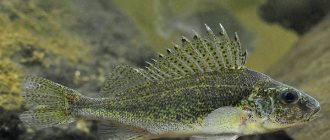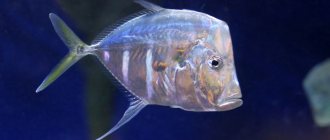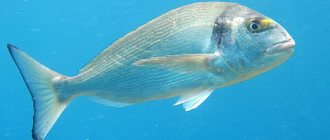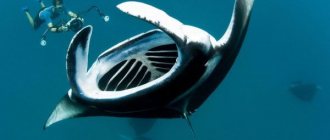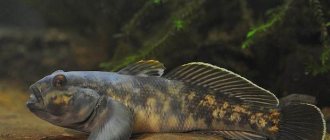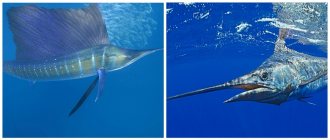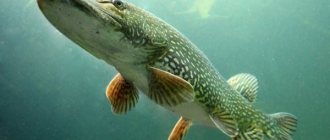- Wild animals
- >>
- Fish
Marlin is a species of large, long-nosed marine fish characterized by an elongated body, a long dorsal fin, and a rounded snout extending from the snout. They are wanderers found around the world near the surface of the sea and are carnivores that feed primarily on other fish. They are consumed as food and are highly prized by sport fishermen.
Origin of the species and description
Photo: Marlin
Marlin is a member of the billfish family, a group of perciformes.
There are usually four main types of marlin mentioned:
- Blue marlin, found throughout the world, is a very large fish, sometimes weighing 450 kg or more. It is a dark blue member of the animal kingdom with a silver belly and often lighter vertical stripes. Blue marlin tend to dive deeper and tire more quickly than other marlin;
- the black marlin becomes as huge or even larger than the blue marlin. It is known to reach a weight of over 700 kg. The Indo-Pacific species is blue or light blue, gray above and lighter below. Its distinctive rigid pectoral fins are angled and cannot be flattened into the body without force;
- Striped marlin, another Indo-Pacific fish, is bluish above and white below with pale vertical stripes. Usually it does not exceed 125 kg. Striped marlin are renowned for their fighting ability and have a reputation for spending more time in the air than in the water once hooked. They are known for long runs and tail walks;
- white marlin (M. albida or T. albidus) is restricted to the Atlantic and is blue-green in color with a lighter belly and pale vertical stripes on its sides. Its maximum weight is about 45 kg. White marlin, despite the fact that they are the smallest species of marlin, weighing no more than 100 kg, are in demand due to their speed, elegant jumping ability and the difficulty of baiting and fishing them.
Beneficial features
The beneficial properties of marlin meat include the following factors:
- Availability of Omega-3 acids . Omega-3 acids promote the development of the cardiovascular and nervous systems, and also slow down the aging process of the human body. In addition, they protect the skin from ultraviolet rays and improve joint function.
- A large number of enzymes . The enzymes contained in marlin meat primarily affect mood. Thanks to them, a person will always be in a positive mood. The risk of becoming depressed also decreases.
- Phosphorus content . Phosphorus has an effect on bone and dental tissue, promotes their improvement and development. This substance is also involved in the synthesis of proteins, fats and carbohydrates. With a lack of phosphorus, the human body becomes weakened, and mental activity begins to decline.
- Availability of vitamins . Marlin meat contains the most vitamin D. It has a positive effect on the condition of the skin and is also involved in the formation of dental tissue. People who get enough vitamin D rarely suffer from lack of sleep and almost never become depressed.
- Small number of bones . Fish meat contains virtually no bones, making it possible for children to consume it. This also makes cutting fish fillets into pieces much easier.
- Low calorie content . Due to its low calorie content, marlin dishes are in demand among people suffering from excess weight. This meat is also consumed by people who pay great attention to their diet and health.
- High protein content . Protein is the main building substance in the human body. It is responsible for muscle contraction, and also takes part in storing and transmitting information within the body.
Appearance and features
Photo: What marlin looks like
The signs of a blue marlin are as follows:
- a pointed anterior dorsal fin that never reaches its maximum body depth;
- the pectoral (lateral) fins are not rigid, but can be folded back towards the body;
- a cobalt blue back that fades to white. The animal has pale blue stripes that always disappear after death;
- the general shape of the body is cylindrical.
Fun fact: Black marlin are sometimes called the "bull of the sea" due to their extreme strength, large size, and incredible endurance when hooked. All this obviously makes them a very popular fish. They may sometimes have a silvery haze covering their body, meaning they are sometimes called "silver marlin".
Video: Marlin
Signs of a black marlin:
- low dorsal fin relative to body depth (smaller than most marlin);
- the beak and body are shorter than those of other species;
- the dark blue back fades to a silver belly;
- rigid pectoral fins that cannot fold.
White marlin are easy to spot. Here's what to look for:
- the dorsal fin is rounded, often exceeding the depth of the body;
- lighter, sometimes green color;
- spots on the belly, as well as on the dorsal and anal fins.
The characteristic features of striped marlin are as follows:
- a pointed dorsal fin that may extend above its body depth;
- light blue stripes are visible that remain even after death;
- thinner, more compressed body shape;
- flexible pointed pectoral fins.
Cooking methods
There are many ways to prepare marlin. Now we will consider the 2 most popular of them:
- Method number 1 . First of all, you need to cut the fish fillets into small steaks, about 2 cm thick. Next, you need to salt the fish and let it stand for about an hour. After this, the onion and garlic are finely chopped, followed by frying it in a frying pan. Next, add water (3 cups), sliced olives, cheese and cream. The sauce should simmer for about 5 minutes, after which it can be removed from the stove. And only the last step is frying the steaks themselves. Finally, you need to place them on a plate, then pour over the previously prepared sauce.
- Method number 2 . This cooking recipe is called “Hawaiian style”. This means that the fish will not be cooked. To prepare, you need to cut the fish into steaks, and then mix it with onions and peppers. Then sesame seeds, soy sauce, butter, salt and sugar are added to it to taste. At the end, the fish is put into the refrigerator for about 2 hours, after which it can be served.
Where do marlin live?
Photo: Marlin in the Atlantic Ocean
Blue marlin are pelagic fish, but they are rarely found in ocean waters less than 100 meters deep. Compared to other marlins, blues have the most tropical distribution. They can be found in the eastern and western waters of Australia and, depending on warm ocean currents, as far south as Tasmania. Blue marlin can be found in the Pacific and Atlantic oceans. Some experts believe that blue marlin, found in the Pacific and Atlantic oceans, are two different species, although this view is disputed. This seems to be because marlin in the Pacific tend to be larger than those in the Atlantic.
Black marlin typically live in the tropical Indian and Pacific oceans. They swim in coastal waters and around reefs and islands, but also roam the open sea. Very rarely they come to temperate waters, sometimes traveling around the Cape of Good Hope into the Atlantic.
White marlin live in tropical and seasonally temperate Atlantic waters, including the Gulf of Mexico, Caribbean Sea and Western Mediterranean. They can often be found in relatively shallow water close to shore.
Striped marlin is found in tropical and temperate waters of the Pacific and Indian oceans. Striped marlin is a highly migratory pelagic species found at depths of 289 meters. They are rarely seen in coastal waters except when there are sharp drops into deeper waters. Striped marlin are mostly solitary, but during the spawning season they form small groups. They hunt prey in surface waters at night.
Now you know where marlin lives. Let's see what this fish eats.
Interesting Facts
The Atlantic giant is the largest bony fish and has practically no enemies; few people dare to attack a 2-5-meter fish. Tasty, valuable meat, as well as record sizes, motivate many fishermen to take on risky fishing, but after the photo shoot, most of the caught trophies were released back into the sea. There are many rumors and legends about the giant fish, here are some of them:
Marlin reproduce in small schools; individuals that have reached 2-4 years of age are considered sexually mature. The mating season occurs at the beginning of autumn; after fertilization, the female is able to lay up to 7 million eggs.
Young fry are carried by the current to different parts of the Atlantic Ocean, many die from attacks by larger fish.
Source
What does marlin eat?
Photo: Marlin fish
Blue marlin are solitary fish that are known to undergo regular seasonal migrations, moving toward the equator during winter and summer. They feed on epipelagic fish including mackerel, sardines and anchovies. They may also feed on squid and small crustaceans when given the opportunity. Blue marlin are among the fastest fish in the ocean and use their beaks to fight their way through dense schools and return to feed on their dazed and wounded victims.
Black marlin are apex predators that feed primarily on small tuna, but also other fish, squid, cuttlefish, octopus and even large crustaceans. What is defined as a "smaller fish" is a relative term, especially considering that a large marlin weighing over 500kg was found with a tuna weighing over 50kg in its belly.
Interesting Fact: Research off the east coast of Australia shows that black marlin catches increase during the full moon and week after their prey species move deeper from the surface layers, forcing the marlin to forage over a wider area.
White marlin feed near the surface during the day on a variety of fish, including mackerel, herring, dolphin and flying fish, as well as squid and crabs.
Striped marlin is a very powerful predator, feeding on a variety of small fish and aquatic animals such as mackerel, squid, sardines, anchovies, lancefish, sardines and tuna. They hunt in areas from the surface of the ocean to a depth of 100 meters. Unlike other species of marlin, striped marlin chops its prey with its bill rather than piercing it.
Basic nutrition
Being a predator by nature, the blue marlin fish hunts mackerel, tuna, flying fish, and occasionally squid and cephalopods. Seeing a school of fish, the sailboat accelerates and attacks, stringing the frightened prey onto its spear or swallowing it along the way. Water that gets into the mouth during hunting passes through the gills, enriching the body with oxygen and giving the predator energy.
The mackerel spawning season is considered a real feast , when these places are literally teeming with ray-finned and other predatory fish.
Features of character and lifestyle
Photo: Blue Marlin
Marlin are aggressive, highly predatory fish that respond well to the splash and wake of well-presented artificial bait.
Fun Fact: Fishing for marlin is one of the most exciting challenges for any angler. Marlin is fast, he is athletic, and he can be very huge. Striped marlin is the second fastest fish in the world, swimming at speeds of up to 80 km/h. The speed of black and blue marlin also leaves most of the other fish that follow them behind.
Once hooked, marlin exhibit acrobatic abilities worthy of a ballerina—or perhaps it would be more accurate to compare them to a bull. They dance and leap through the air at the end of your line, giving the angler the fight of his life. It's no surprise that marlin fishing has an almost legendary status among anglers around the world.
Striped marlin is one of the most dominant fish species and has some interesting behavior patterns:
- these fish are solitary in nature and usually live alone;
- they form small groups during the spawning period;
- this species hunts during the daytime;
- they use their long beak for hunting and also for defensive purposes;
- these fish are often found swimming around bait balls (small fish swimming in compact spherical formations), causing them to get sucked in. They then swim through the bait ball at high speed, catching weaker prey.
Social structure and reproduction
Photo: Atlantic Marlin
Blue marlin migrate frequently and therefore little is known about their spawning periods and behavior. However, they are very prolific, producing up to 500,000 eggs per spawning. They can live up to 20 years. Blue marlin spawn in the central Pacific Ocean and central Mexico. They prefer water temperatures between 20 and 25 degrees Celsius and spend most of their time near the surface of the water.
Known spawning areas for black marlin, based on the presence of larvae and juveniles, are limited to warmer tropical zones when water temperatures are around 27-28° Celsius. Spawning occurs at specific times in specific regions in the western and northern Pacific, in the Indian Ocean on the northwest shelf off Exmouth, and most widely in the Coral Sea off the Great Barrier Reef off Cairns during October and November. Here, suspected pre-spawning behavior was observed when "larger" females were followed by several smaller males. A female black marlin's egg count can exceed 40 million per fish.
Striped marlin reaches sexual maturity at the age of 2-3 years. Males mature earlier than females. Spawning occurs in summer. Striped marlin are multi-mating animals with females releasing eggs every few days, with 4–41 spawning events occurring during the spawning season. Females can produce up to 120 million eggs per spawning season. The spawning process of white marlin has not yet been studied in detail. What is known is that spawning occurs in the summer in deep ocean waters with high surface temperatures.
Natural enemies of marlins
Photo: Big marlin
Marlins have no other natural predators other than people who fish for them commercially. Some of the world's best marlin fishing occurs in the warm Pacific waters around Hawaii. There are probably more blue marlin caught here than anywhere else in the world, and some of the largest marlin ever recorded were caught on this island. The western town of Kona is known throughout the world for its marlin fishing, not only because of the frequency of big fish caught, but also because of the skill and experience of its top captains.
From late March through July, charter boats sailing from Cozumel and Cancun encounter masses of blue and white marlin, as well as other white fish such as sailfish that head into the warm waters of the Gulf Stream into the area. Blue marlin are generally smaller here than in the central Pacific. However, the smaller the fish, the more athletic it is, so the fisherman will still find himself in an exciting fight.
The first black marlin ever caught on rod and reel was caught by a Sydney doctor fishing from Port Stephens, New South Wales in 1913. Australia's east coast is now a mecca for marlin fishing, with blue and black marlin often caught on fishing charters in this area.
The Great Barrier Reef is the only confirmed breeding ground for black marlin, making eastern Australia one of the most popular black marlin fishing destinations in the world.
Striped marlin are traditionally the main whalefish species in New Zealand, although blue marlin are occasionally caught by anglers there. In fact, blue marlin catches in the Pacific Ocean have increased over the past ten years. Now they are constantly found in the bays of the islands. Waihau Bay and Runaway Point are particularly well known marlin fishing grounds.
Population and species status
Photo: What marlin looks like
According to a 2016 assessment, Pacific blue marlin are not overfished. Population estimates for Pacific blue marlin are conducted by the Billfish Working Group, a division of the International Scientific Committee on Tuna and Tuna-Like Species in the North Pacific Ocean.
The prized white marlin is one of the most exploited fish in the open ocean. It is the subject of intense international restoration efforts. New research now shows that a similar species, the round billfish, makes up a relatively high proportion of fish identified as "white marlin." Thus, current biological information on white marlin is likely skewed by the second species, and past estimates of white marlin population size are currently uncertain.
Black marlin have not yet been assessed as to whether they are a threatened or endangered species. Their meat is sold chilled or frozen in the United States and prepared as sashimi in Japan. However, they are banned in some parts of Australia due to their high selenium and mercury content.
Striped marlin is listed in the Red Book and is a protected species of marlin. In Australia, striped marlin are caught throughout the east and west coasts and are a target species for anglers. Striped marlin is a species that prefers tropical, temperate and sometimes cold waters. Striped marlin are also occasionally caught recreationally off Queensland, New South Wales and Victoria. These recreational fisheries are managed by state governments.
Striped marlin is not included on the IUCN Red List of Threatened Species. However, Greenpeace International included these fish on its seafood red list in 2010, as their numbers are declining due to overfishing. Commercial fishing of this fish has become illegal in many regions. People who catch these fish recreationally are advised to put them back into the water rather than consume or sell them.
